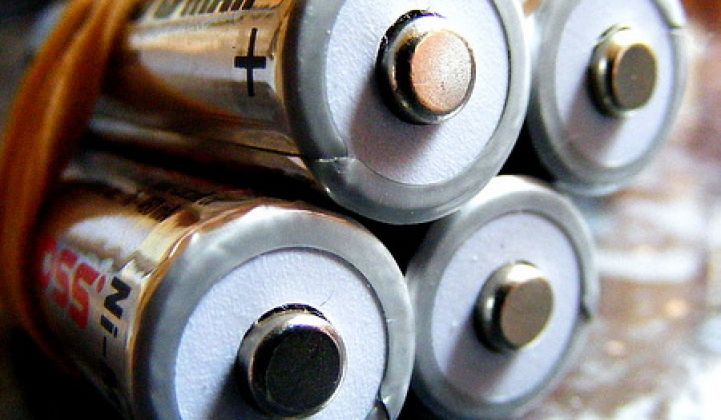Magnesium is the eighth most abundant element in the earth’s crust. Pellion Technologies hopes to make magnesium-ion batteries abundant on the earth’s surface.
In 2009, Khosla Ventures provided Massachusetts-based Pellion with seed capital (here's Mr. Khosla talking about energy storage). In 2010, ARPA-E awarded the startup a $3.2 million grant. Now, the company is willing to talk about its progress.
According to Pellion, its rechargeable magnesium battery will have a higher energy density (energy per unit volume) and specific energy (energy per unit weight) than today’s lithium-ion batteries, which are used in portable electronics and electric vehicles.
“Because magnesium-ions transfer two electrons per atom, if you intercalate magnesium instead of lithium into a suitable cathode, you get twice the energy density right off the bat,” said Josh Nevin, Pellion’s VP of Operations and Business Development. “The other key is the magnesium metal anode, [which] provides much higher energy density than conventional lithium-ion anodes. The net result is a battery with up to three times the energy density of state-of the-art lithium-ion batteries”
Pellion also claims that its magnesium battery will have a longer cycle life than today’s lithium-ion battery.
“When you cycle a lithium anode, the lithium metal that plates grows like moss on a tree. This can eventually lead to problems,” said Nevin. “We don’t have that problem with magnesium, [which] plates in a nice, uniform distribution. Our team has been able to demonstrate over 3,000 cycles at 100 percent depth of discharge with less than 15 percent capacity fade.”
Magnesium is not only plentiful, but also inexpensive and safe. In addition, magnesium batteries have the potential to be drop-in replacements for lithium-ion batteries.
So far, so good. But to commercialize a rechargeable battery that uses a magnesium metal anode, Pellion must also select a complementary cathode. That’s the rub; previous efforts to develop a magnesium battery have failed to identify a suitable cathode.
In 2000, Doron Aurbach, a Professor of Chemistry at Israel’s Bar-Ilan University, demonstrated the first rechargeable magnesium battery. The discovery generated significant, if short-lived, interest. Aurbach had used a less-than-ideal cathode and therefore demonstrated a battery with low energy density.
For the next decade, neither Aurbach nor his colleagues were able to identify a better cathode. As a result, interest in magnesium batteries waned.
“Many researchers simply moved on. We think that was shortsighted,” said Nevin. “Professor Aurbach’s battery really had phenomenal performance and was only limited by its cathode.”
To identify a better cathode, Pellion begins with a computational screen. As the company zeroes in on potential targets, it engages in targeted synthesis and electrochemical testing.
“Before we make any material, we compute its fundamental properties in a high-performance computing environment, literally at the electron level,” said Nevin. “We compute voltage, capacity, and mobility. We conduct very fundamental science, computationally, well before we synthesize anything in the lab.”
Pellion's co-founders are Gerbrand Ceder, a Professor of Materials Science and Engineering at MIT, and Kristin Persson, a chemist at Lawrence Berkeley National Laboratory. The company’s team includes Edward Buiel, the former CTO of Axion Power, and Aurbach, who serves as a scientific advisor.
By leveraging its high-throughput techniques, Pellion has already tested more than 10,000 cathode candidates. The company has zeroed in on about a dozen materials -- Nevin won’t go into further detail -- which it is testing and cycling in its lab. Pellion has also developed “several classes of electrolytes” -- again, no additional details, for now -- for potential use in its magnesium battery.
Of course, magnesium is but one of many potential lithium alternatives. Researchers and entrepreneurs are exploring Li-S, Li-air, Li-cobalt, Zn-air and Na-metal halide, among many other approaches. And Pellion isn’t alone in working to commercialize magnesium-ion batteries. Earlier this year, Toyota revealed that it too is developing a magnesium battery.
Toyota has estimated that its magnesium battery won’t be available until 2020. In June, ARPA-E acknowledged Pellion was one of its riskier projects.
Still, the Pellion team is undeterred and believes it is well on its way to solving magnesium’s historic challenges. For example, a longstanding challenge in magnesium battery development has been magnesium’s lower mobility relative to lithium, which has limited magnesium’s rate of charge and discharge.
“With our computations, we have shown there are materials with magnesium mobility comparable to that of lithium in common lithium-ion systems,” said Nevin. “Magnesium mobility is not nearly the problem many feared.”
***
Yoni Cohen is a student at the Yale Law School and a former college basketball writer for Fox Sports. He has worked for cleantech venture capital firms in San Francisco and Israel and has reported about environmental innovation for numerous publications. Before law school, he served as an advisor to candidates for and members of Congress. Follow Yoni on twitter @Cohen_Yoni.



